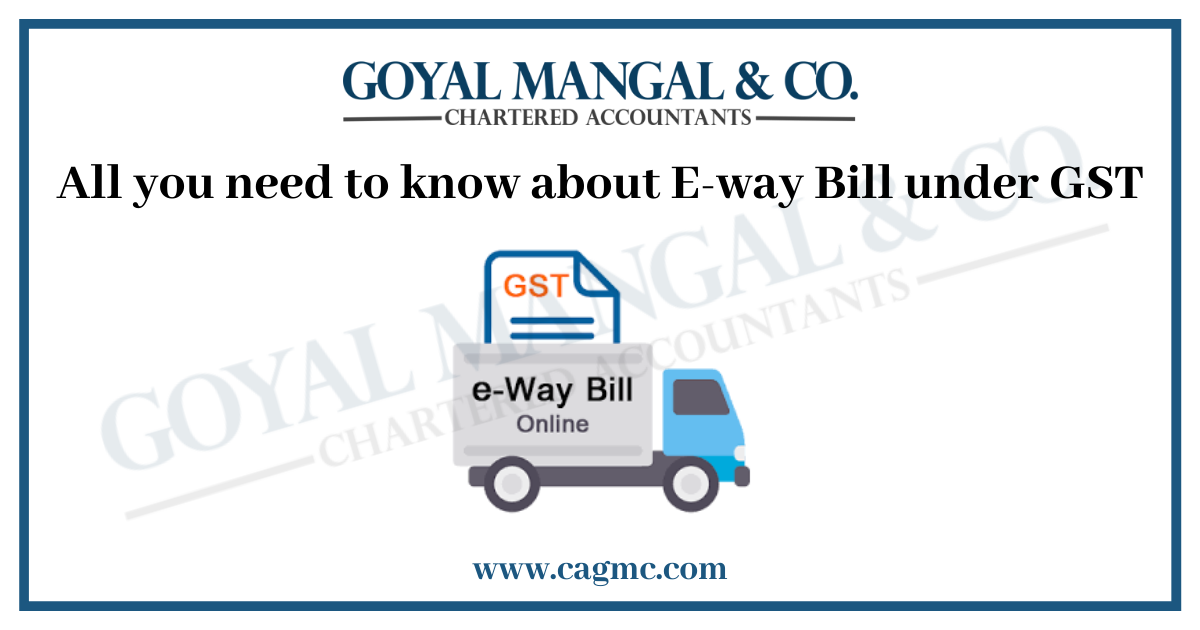
E- way bill under GST or Electronic way bill as we call it was introduced on 1st April 2018. It is a document generated before transporting goods costing more than Rs. 50,000. The transporters have a physical copy of the e-way bill. It includes the information such as goods, recipients, consignor, and transporter.
In this article, we will learn about the e-way bill under GST, the procedure and format of e-way bills, and the important dates for the e-way bill in India.
What is E-Way Bill?
E-way Bill or Electronic way bill under GST is a very crucial electronic document which the person in charge of conveyance carries under Rule 138 and section 68 of the GST Act. This bill is for a particular consignment having movement of goods. One should have an e-way bill if the consignment of goods exceeds Rs. 50,000 under section 68 of the Goods and Services Tax Act r/w Rule 138. It is basically instructions relating to the shipment and the details like consignor and consignee names, the origin of the consignment, and the destination.
It is a document as a evidence of the movement of goods. Moreover, it has two components, Part A has details like Recipients GSTIN, the place of delivery, invoice or challan, the value of goods, HSN code, transport document. Part B has all the transporter details. It is a compliance mechanism for the movement of goods.
Rule 138 of the CGST Rules, 2017 also discusses about the e-way bill mechanism. Additionally, it is very important to furnish all the details prior to the commencement of the movement of goods.
It is generated from the GST portal by the transporters who have the right to cause the movement of consignment before the commencement of movement.
Purpose of E-way Bill
An e-way bill under GST ensures that the goods under transportation comply with the GST Laws in India. It is an effective way to track the movement of goods and avoid tax evasion.
Importance of E-way Bill under GST
An e-way bill under GST is generated whenever there is a movement of goods valuing more than Rs. 50,000. Furthermore, we can say that this e-way bill is always in relation to the supply, due to inward supply from any unregistered person and for reasons other than supply.
Under Section 68 the person who is in charge of conveyance has to carry e-way. Bill if the consignment exceeds the prescribed limits. Additionally, Rule 138 of CGST Rules, 2017 also states the same rules for the consignment of goods.
When is the E-way bill under GST issued?
A supply can be for consideration in the course of business or outside the course of business. It can also be without consideration. It simply means a sale, transfer or barter, or exchange.
An e-way bill is generated in the common GST portal for the movement of goods. It is mandatory to generate an e-way bill under GST if the consignment cost is less than Rs. 50,000 in case of inter-state movement of the goods and inter-state transport of handicraft goods by people or dealers who are exempt from GST Registration.
Generation of E-Way Bill
The procedure for the movement of goods is well prescribed in the e-way bill rules. The transporter of the goods has the power to generate the e-way bill. He has to be registered, if he is unregistered, he can enroll on the GST portal and generate the e-way bill for the movement of goods. This portal is a gateway for the generation of the e-way bill, cancellation of the e-way bill, etc. One can generate this e-way bill under GST by web, SMS, or e-invoicing.
The consignee or consignor can generate the e-way bill if the transportation is done on his own or hired conveyance, by rail, air, or any other vessel. Furthermore, if the goods are given to the transporter for transportation via road, he can generate the e-way bill. In case the value of the goods is more than Rs. 50,000 and the consignor and consignee don’t generate the e-way bill, then it is the responsibility of the transporter to get the e-way bill.
Essential Documents for E-Way Bill under GST
- Firstly, the applicant has to register on the e-way bill portal.
- Secondly, he should have the invoice related to the consignment. Moreover, if the transport is by road, he should have a transporter ID or a vehicle number.
- If the transport is via railway, air, or vessel, the applicant should have a transporter ID and document number.
Format of E-way Bill
The E-way Bill under GST has two parts- Part A and B.
- Part Acomprises of the GSTIN of the recipient, the place of delivery, invoice, the value of the goods, the reason for transportation, and the document number. It should also have an HSN code. It is compulsory to mention the first two digits of the code if the turnover is up to Rs. 5 crore. If the turnover is more than Rs. 5 crores then Part A should include 4 digits of the code.
- The transporter submits the vehicle number in Part B.
Procedure for generating E-way Bill
Following is a step by step guide to generate the e-way bill on the e-way bill portal-
Step 1 – The applicant has to log in the bill system by entering the username and password.
Step 2 – He has to generate a new entry form and fill in the details. He has to fill in the transaction type, subtype, and document. If someone is the supplier he has to mention outward in transaction type and inward if he is the recipient.
The applicant has to submit the invoice or challan documents along with the document number and date. They also have to mention the from and to depending on whether they are recipients or suppliers. If the person is unregistered, then they have to mention URP in place of GSTIN indicating that they are unregistered.
The applicant has to mention details of the consignment, for example, the product name, description, HSN Code, unit, value, tax rates of CGST or SGST, or a tax rate of cess.
The applicant also states the mode of transport, the distance along with the transporter’s name, ID, document number, or vehicle number.
Step 3 – After filling the application, one has to click on the Submit button. Thereafter the system validates the data. The E-way bill number, date, validity, GSTIN, place of delivery, HSN Code, and reason for transportation is specified in Part A of the bill. Part B includes the mode and vehicle number.
Lastly, the applicant has to print the e-way bill for the transportation of goods.
Validity of E-way Bill in India
The validity of the e-way bill wholly depends on the total distance. If the distance is less than 100 Km then the e-way bill is valid for a day for every 100 km. After every 100 Km, the validity increases by one day from the prescribed relevant date. There is one-day validity in the case of over-dimensional cargo vehicles for every 20 Km. For up to 200 km there is one-day validity and for every 200 km there is an additional day of validity.
The day the e-bill generates us the relevant date. We count the validity period from the date of generation of e-way bill.
The validity of the e-way bill can extend under exceptional circumstances. And if there are exceptional circumstances and the transportation cannot be complete within the validity period, then the transporter can generate another e-way bill after updating the information in Part B of Form GST EWB-01.
E-way bill Exceptions
There is no requirement of E-way bill in the following conditions-
- When there is the transportation of goods specified in Rule 138 of the CGST Rules, 2017 annexure.
- Goods exempted from GST.
- If there is the transportation of goods through a non-motorized conveyance.
- When the transportation is from a port, airport, or cargo complex or a customs station to an inland container depot or station.
- In case the cargo containers are empty.
- When the goods are exempt in a particular state or UT GST Rules.
- If there is a movement of goods under the Ministry of Defence. When there is a transit cargo to or from Nepal or Bhutan.
- If movement of goods under rule 138(14) (d) of the SGST Rules, 2017 and lastly if the consignment is less than Rs. 50,000.
Conclusion
The E-way bill was introduced in a phased manner in India with an aim to promote hassle-free movement of goods throughout India. This bill plays a crucial role in the tax administration of the government. The e-way bill improves transparency and has multiple modes to prevent rejection of the bill. E-way bill under GST brings uniformity in the rules and regulations and facilitates faster movement of the goods.


